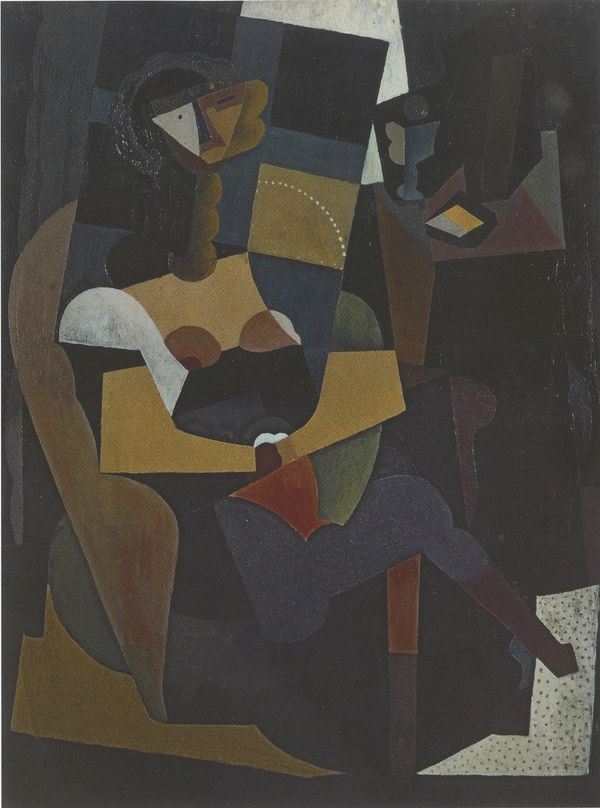Diego Rivera Retrato de Marevna (Portrait of Marevna), 1916
Between the years of 1912 and 1917, Mexican artist Diego Rivera enjoyed a fruitful career as a cubist painter in Paris. His serious work as a theorist and as an exponent of Cubism led him to emerge as a distinctive member of the vanguard movement and a contemporary of Pablo Picasso, Jean Metzinger and Gino Severini. After beginning his artistic studies at the Escuela Nacional de Bellas Artes in Mexico City as an academic painter well-versed in the Modernist and Post-Impressionist movements, Rivera perfected his studies in Spain between 1907 and 1909, briefly returning to Mexico and then back to Europe in 1911 to open his studio in Montparnasse, where he began experimenting with Divisionism under the influence of Georges Seurat.
Rivera conceived his first Cubist compositions during the winter of 1912, evolving from the Mannerist paintings of El Greco (Doménikos Theotokópoulus) and went on to exhibit some of these works at the autumn Salon in Paris. Rivera's Cubism followed a path that led from the early influences of Robert Delaunay's Orphism and Italian Futurism to his own characteristically complex formal language. He incorporated textures achieved with sand and cork and a rich Orphic chromatic palette which his detractors considered savage and primitive until it arrived at the conception of enveloping compositional spaces including extremely dynamic centrifugal and centripetal energies.
Around the year 1916, Diego Rivera began to refine his Cubism towards a more purist abstraction of austere geometric shapes, as seen in Rivera's portrait from 1916 — up for auction in our Latin America sale — which was incorrectly catalogued as a portrait of Angeline Beloff for decades. In reality, this painting is a portrait of another Russian painter, Marie Bronislava Vorobyeva-Stebelska, "Marevna" (1892-1984), whom Rivera met around the year 1915 as a result of their mutual friendship with the poet Ilya Ehrenburg. Rivera had a passionate affair with Marevna, which although ephemeral, produced a daughter named Marika.
Marevna Self Portrait, 1929
On the other hand, Rivera maintained his romantic attachment with the painter Angeline Beloff (1879-1969) from the time he met her in 1909. With Beloff, who became his common-law wife, Rivera had a male child, Diegito, who died a few months after birth. This produced difficult moments of avoidance and rejection in his relationship with his stable romantic partner. It was within this period of instability that Rivera was briefly involved with Marevna, whose savage beauty and overflowing sexual energy — the polar opposite of the serene and maternal presence of Angeline — captivated the Mexican painter, estranging him for a period from the marital relationship he had with Beloff between 1911 and 1921.
Photograph of Diego Rivera and Angelina Beloff, Paris 1911
This is the second Cubist portrait of three portraits of Marevna created by Rivera. The first one is in the Art Institute of Chicago's permanent collection and shares the same characteristic geometric facial features with this second painting. The last one, created in 1917 and known as Mujer sentada en una butaca (Woman sitting in an armchair), is included in the collection of the Instituto Nacional de Bellas Artes in Mexico City.
Every good composition is above all a work of abstraction. All good painters know this. But the painter cannot dispense with subjects altogether without his work suffering impoverishment.
—Diego Rivera
Diego Rivera Woman Sitting in an Armchair, 1917
Painted in 1916, the work coming to our auction is a magnificent piece that has only been held in two private collections, since it was acquired directly from the painter, and evidences to what point Rivera had managed to strip himself from any decorative and accessory elements in his conception of Cubism. Marevna's blond hair and figure are shown from the front and back, rotating on the same central axis, with a chromatic play on blacks versus whites, creating the juxtaposition of grand positive spaces confronted by richly textured dark planes.
Thus, Marevna's mercurial personality, which Rivera found "exciting" but which also defined her as a "she-devil," is reflected in the shifting perspectives of her body now geometric with her hands on her hips, shaped as a cube dancing seductively on the canvas surface, growing dynamic and full of energy as a result of Rivera's compositional talent and the spatial innovations he achieved as a renowned Cubist painter in Paris.



